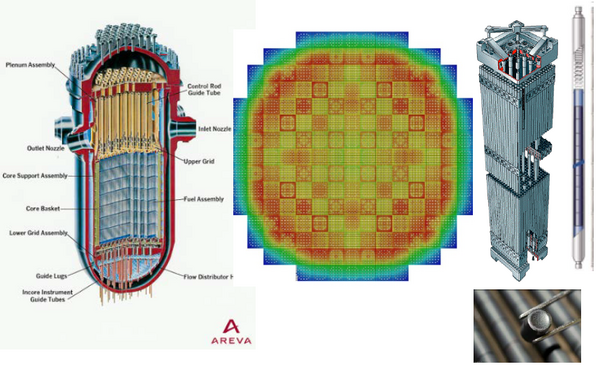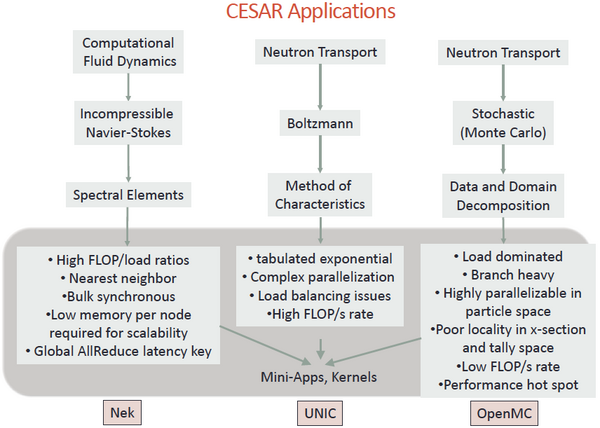CESAR
From Modelado Foundation
| CESAR | |
|---|---|
 | |
| Developer(s) | Center for Exascale Simulation of Advanced Reactors, ANL |
| Stable Release | x.y.z/Latest Release Date here |
| Operating Systems | Linux, Unix, etc.? |
| Type | Physics? |
| License | Open Source or else? |
| Website | https://cesar.mcs.anl.gov/ |
CESAR (Center for Exascale Simulation of Advanced Reactors)
Goals
- Developing algorithms to enable efficient reactor physics calculations on exascale computing platforms
- Influencing exascale hardware/x-stack priorities, innovation based on “needs” key algorithms
Challenge
CESAR Challenge: Predict Pellet-by-Pellet Power Densities and Nuclide Inventories for the Full Life of Reactor Fuel (~5 years)
Applications
Proxy Apps
- Mini-apps: reduced versions of applications intended to …
- Enable communication of application characteristics to non-experts
- Simplify deployment of applications on range of computing systems
- Facilitate testing with new programming models, hardware, etc.
- Serve as a basis for performance model, profiling
- Must distinguish between code and application of code
- One key for mini-app is to appropriately constrain problem, input etc.
- We all worry about abstracting away important features
- For CESAR the three key mini-apps are
- Nek-bone: spectral element poisson equation on a square
- MOC-FE: 3d ray tracing (method of characteristics) on a cube
- mini-OpenMC: Monte Carlo transport on a pre-built simplified lattice
- TRIDENT: transport/cfd coupling, still under development
- Algorithmic innovations for exascale embedded in kernel apps:
- MCCK, EBMS, TRSM, etc.
Monte Carlo LWR
- What is the scale of Monte Carlo LWR Problem?
- State of the art MC codes can perform single-step depletion with 1% statistical accuracy for 7,000,000 pin power zones in ~100,000 core-hours
- What is needed for Exascale Application of Monte Carlo LWR Analysis?
- Efficient on-node parallelism for particle tracking (70% scalability on up to 48 cores per node but wide variation and possible limitations)
- The ability to execute efficiently with non-local 1 T-byte data tallies
- The ability to access very large x-section lookup tables efficiently during tracking
- The ability to treat temperature-dependent cross sections data in each zone
- The ability to couple to detailed fuels/fluids computational modeling fields
- The ability to efficiently converge neutronics in non-linear coupled fields
- Capability of bit-wise reproducibility for licensing: data resiliency model key
Co-design Opportunities
Co-design opportunities for Temperature-Dependent Cross Sections
- Cross section data size:
- ~2 G-byte for 300 isotopes at one temperature
- ~200 G-byte for tabulation over 300K-2500K in 25K intervals
- Data is static during all calculations
- Exceeds node memory of anticipated machines
- Represent data with discrete temperature approximate expansions?
- New evidence that 20-term expansion may be acceptable
- ~40 G-byte for 300 isotopes
- Large manpower effort to preprocess data
- Many cache misses because data is randomly accessed during simulations
- NV-Ram Potential?
- Data is static during all simulations
- Size NV-RAM needed depends on data tabulation or expansion approach
- Static data beckons for non-volatile storage to reduce power requirements
- Access rate needs to be very high for efficient particle tracking
- Data is static during all simulations
Co-design Opportunities for Large Tallies
- Spatial domain decomposition?
- Straightforward to solve tally problems with limited-memory nodes
- Communication is 6-node nearest-neighbor coupling
- Small zones have large neutron leakage rates –> implications for exascale
- Using a small number of spatial domains may allow data to fit in on-node memory
- Communications requirements may be significant
- Tally-server approach for single-domain geometrical representation?
- Relatively small number of nodes can be used as tally servers
- Each tally server stores a small fraction of total tally data
- Asynchronous writes eliminate tally storage on compute nodes
- Compute nodes do not wait for tally communication to be completed
- Local node buffering may be needed to reduce communication overhead
- Communications requirements may be still be significant
- Global communication load may become the limiting concern
Co-design opportunities for Temperature-Dependent Cross Sections
- Direct re-computation of Doppler broadening?
- Cullen’s method to compute cross section integral directly from 00K data, or
- Stochastically sample thermal motion physics to compute broadened data
- Never store temperature-dependent data, only the 00K data
- Cache misses will be much smaller than with tabularized data
- Flop requirement may be large, but it is easily vectorizable
- Energy domain decomposition?
- Split energy range into a small number (~5-20) energy “supergroups”
- Bank group-to-group scattering sites when neutrons leave a domain
- Exhaust particle bank for one domain before moving to next domain
- Use server nodes to move cross section only for the active domain
- Modest effort to restructure simulation codes
- Cache misses will be much smaller than with full range tabularized data
- Communication requirements can be reduced by employing large particle batches


